- Revenue Cycle Management
- COVID-19
- Reimbursement
- Diabetes Awareness Month
- Risk Management
- Patient Retention
- Staffing
- Medical Economics® 100th Anniversary
- Coding and documentation
- Business of Endocrinology
- Telehealth
- Physicians Financial News
- Cybersecurity
- Cardiovascular Clinical Consult
- Locum Tenens, brought to you by LocumLife®
- Weight Management
- Business of Women's Health
- Practice Efficiency
- Finance and Wealth
- EHRs
- Remote Patient Monitoring
- Sponsored Webinars
- Medical Technology
- Billing and collections
- Acute Pain Management
- Exclusive Content
- Value-based Care
- Business of Pediatrics
- Concierge Medicine 2.0 by Castle Connolly Private Health Partners
- Practice Growth
- Concierge Medicine
- Business of Cardiology
- Implementing the Topcon Ocular Telehealth Platform
- Malpractice
- Influenza
- Sexual Health
- Chronic Conditions
- Technology
- Legal and Policy
- Money
- Opinion
- Vaccines
- Practice Management
- Patient Relations
- Careers
Martin Luther I: The Man, the Reformer, the Beginning
Germany is celebrating 500 Years of Martin Luther until 2017 and there are four towns that really represent his career, starting with Eisleben, where he was born and died.
Photography by the authors
We know a judge tells lawyers who say, “It’s long story, your honor,” with his comment, “In that case start at the end!” But how do you write about Martin Luther, the man who, essentially, single-handedly shaped the Reformation and not start at the beginning?
Germany
is celebrating its 500 years of Luther history. Two regions in the center of the country, Saxony-Anhalt and Thuringia a bit more to the south, make the most claims to Luther’s life. Nine towns had particular contacts but that’s too many for the average tourist to hope to visit even though the DB German train system can work wonders.
Four* really represent epochs in Luther’s career, and limiting your attention to those makes the task of understanding this controversial man easier. Northern Europe is secular, and its guides imply they prefer visitors to come with a sense of history not with intent to proselytize. Understood.
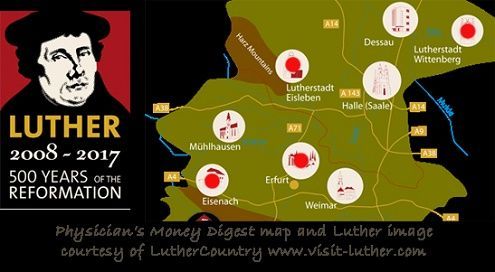
Luther was born in 1483 in Eisleben in Germany. The town — of about 20,000 souls — still has families with his last name (Luder); he is Eisleben’s favorite son.
The town is first mentioned in records that go back to the year 994. It grew at the confluence of two trade routes and increased in size when copper deposits were discovered in the 15th century. Luther’s father was a miner. Family details are laid out in the displays in the reconstructed Luther Birth House. (The original was almost completely destroyed by fire in 1689.)
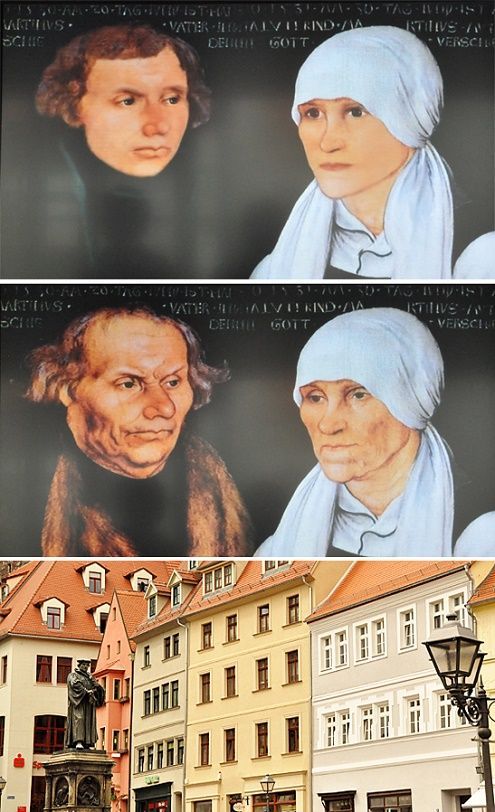
An artist painted his parents when they were young. A program designed to age persons in a portrait to show how they might look when older has created his parents at a later age. It is often displayed with the first. It reminds us that we don’t improve with age.
One wonders if Luther’s parents ever imagined his statue would stand for centuries in the town square. The father was a comfortably-off copper smelter, and later angry when his son gave up law school to enter the Church.
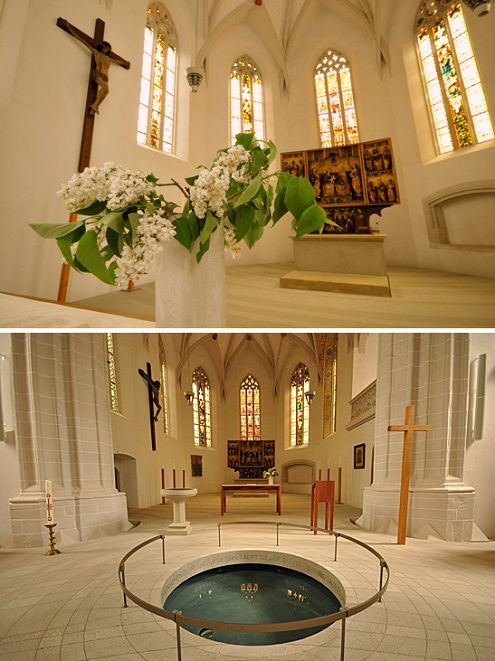
Luther was baptized when one day old in the Church of St. Peter and St. Paul around the corner from where he was born. A town fire in 1689 destroyed much of his former home but it has been reconstructed as a typical house of the Middle Ages. It’s also one of the several Luther museums in this part of central Germany sometimes called Luther Country.” This church of his baptism has been restored and it re-opened in the spring of 2012. Its new immaculate baptism font cannot please historians as it never embraced Luther.
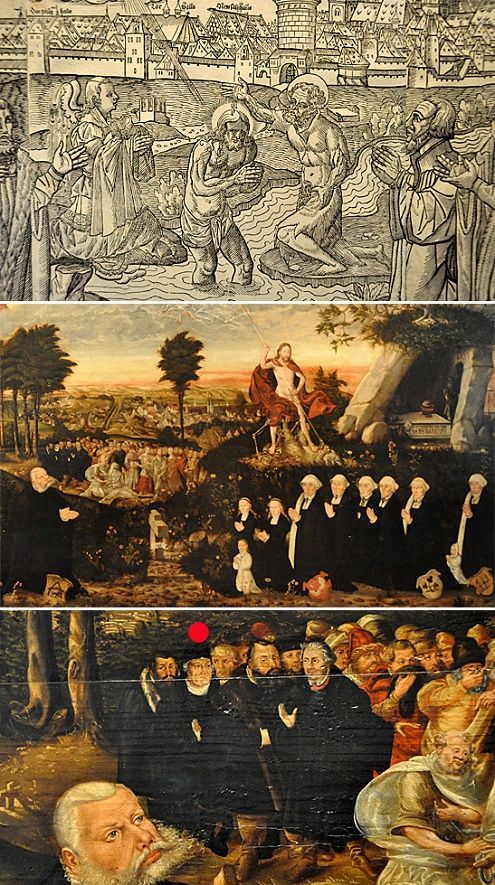
The ceremony of baptism was tremendously important to Luther; it was the basis for all his beliefs. One-third of babies born at this time did not survive the first year and as, said the Church, even newborn infants carried the burden of original sin parents hurried to baptize their babies as soon as possible.
The museum beside his house has a 16th century wood engraving that transfers the baptism of Jesus by John the Baptist from the Jordan to the German Pegnitz river with the medieval town of Eisleben in the background — and Martin Luther himself one of the witnesses. So much for history.
An oil painting done in 1561 on another wall defines the burial of Jakob Heidelberg, a master smelter. It is his epitaph and shows the risen Christ and Lazarus, too, rising from the dead. The praying family is that of the deceased. The congregation that prays also includes Luther (we have put a red dot above his head in the detailed view).
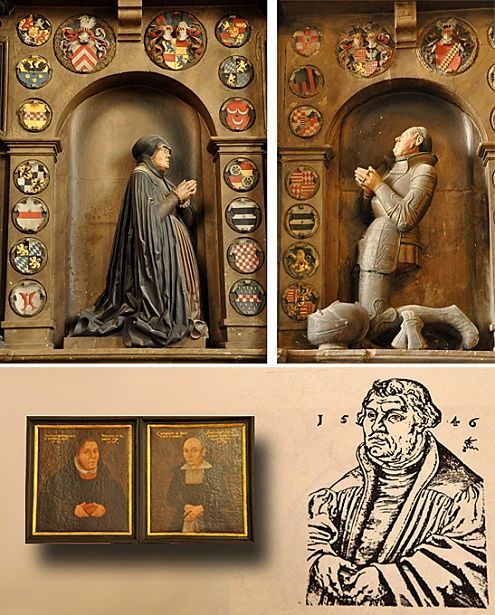
Those pictures and the one that follows of scenes in St. Andrew’s Church beside the town square show the suffocating piety of the times and how men would kill for the Church (the praying man on the right facing his wife is suited in armor) yet the image below shows a priest, Luther, who married a nun!
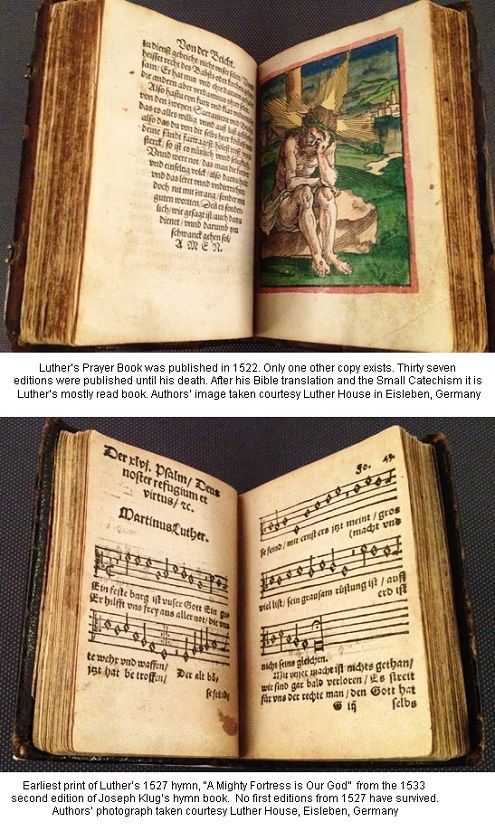
True Luther did great works and wrote great books at a time when printing was in its infancy. It’s an understatement to say he risked a lot. He risked his life. No one can deny his courage.
In 1415 the Catholic Church had burned Jan Hus at the stake for his purported blasphemies. He was the Czech Rector of Prague University and also a clergyman. History shows Hus had his clerical robes torn off and a paper hat placed on his head. He was then marched past a pile of his books already on fire and chained to the stake.
“They will roast a goose now but in a hundred years a swan will come you won’t be able to burn!”
His last name meaning “goose” in Bohemian, legends claim he cried out,
There are several versions of the quote, but those around Luther at the time he allegedly nailed his 95 theses to the Castle Church door in Wittenberg saw him as the swan. Luther’s action came a century and a year after Hus.
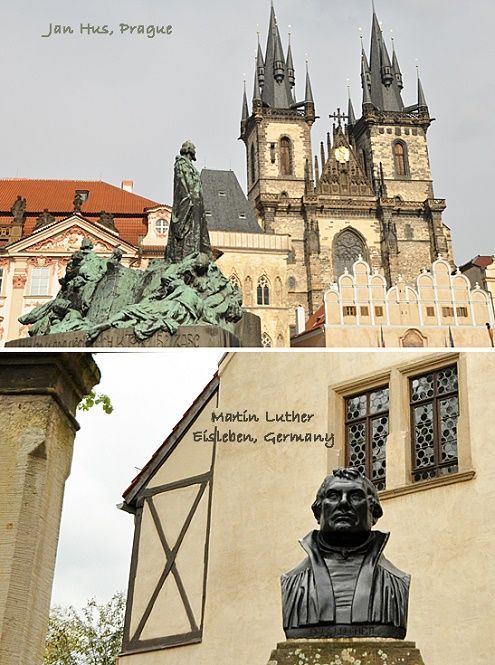
His statue seems to stand in every medieval market place in Germany. “Martin Luther preached from that very pulpit” is heard there as commonly, but improbably, as “George Washington slept here” is claimed in America.
Germany is celebrating 500 Years of Martin Luther until 2017. The extraordinary impact he made on his country is easily demonstrated five centuries later. He left a trail like a comet. And a question for scholars: Was it Martin Luther who made the Reformation or was it the times that made Martin Luther? Was he merely a catalyst?
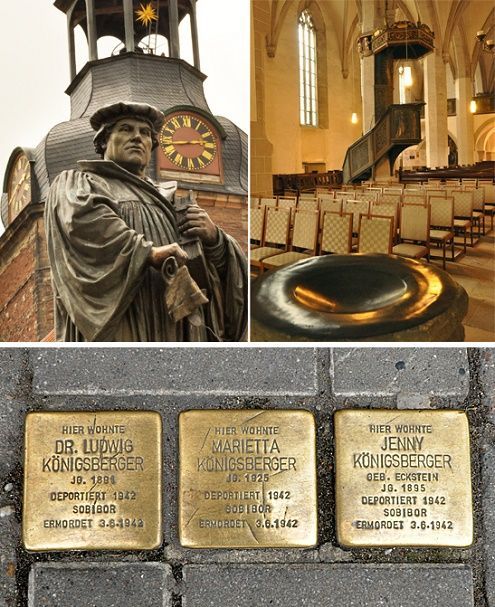
His statue in Eisleben, where he was born and where he died of a stroke shows him as a determined young man. He apparently had Meniere’s disease and later developed angina. His ill health reputedly made him grouchy and bitter. He died at the age of 62 in 1546.
The original pulpit in St. Andrews church where he preached his last sermon still stands. The sermon had, sadly, anti-Semitic tones and he had written books on that theme, too. As we walk away from the church our feet catch on a brass plaque embedded in the sidewalk.
“That is meant to happen!” says our guide. “We call them ‘stumble stones.’ They are meant to remind us of a past we wish hadn’t happened, a past that shames us.”
She explains. The brass signs stand before the house where Dr. Konigsberger and his wife lived with Jenny, their 17-year-old daughter. In 1942 they were arrested, forcedly taken from their home and murdered later that same year. Their crime? Their religion. They were Jews.
Part 2 | Part 3 | Part 4 (coming 8/9/12!)
*The four towns are:
Eisleben
where Martin Luther was born and died.
Erfurt
Wittenberg
where Luther joined the Augustinian monastery and started his life in the Church. where he lived for 35 years, became disillusioned about the Church, wrote his 95 theses and reputedly nailed them to the door of the Castle Church.
Eisenbach
and Wartburg Castle where, excommunicated and outlawed, he translated the Bible from Latin into German.
The Man Who Cried Orange: Stories from a Doctor's Life.
The Andersons, who live in San Diego, are the resident travel & cruise columnists for Physician's Money Digest. Nancy is a former nursing educator, Eric a retired MD. The one-time president of the NH Academy of Family Practice, Eric is the only physician in the Society of American Travel Writers. He has also written five books, the last called
